Tatami is a traditional style of flooring that has continued for over 1,300 years in Japan. The Japanese have spent a lot of time on these beautiful and comfortable mats. With improvements in designs, new tatami has more options to cater to different needs and preferences.
What is Tatami

The word “tatami” is derived from the verb “tatamu”, which means “to fold”. A tatami mat is thin (about 1.5 cm) and can be folded up or piled in layers when not in use. It is a mat used as flooring in traditional Japanese rooms, on which people can sit or sleep comfortably. The size of a tatami is usually 9.1 cm x 18.20 cm. Since tatami are made in standard sizes, they are also used as a standard measurement called “jo.” Traditional Japanese tatami has a tender color and a straw-like aroma. Tatami also helps to control humidity and acts as an insulation layer. To avoid damaging the mat, shoes or slippers can’t be worn when entering a tatami room.
A tatami consists of three parts. The tatami-doko is the inside of the mat, which is traditionally filled with compressed straw. The tatami-omote is the surface. It is woven with a finely woven dried rush. New tatami mats are green in color and turn yellow over time. The tatami-fuchi is the edge of the tatami. Cloth is wrapped around the end of the mat to hide the ends of the woven area, although some tatami do not have these cloths. Made of natural materials, traditional tatami mats are durable, biodegradable, and environmentally friendly.
History of Tatami

The oldest known tatami is from the Nara period (710-784). It was a mat made of five layers of woven makomoko (straw mats) covered with woven dried rush and bordered with brocade. Two of them were placed side by side and used as beds for sleeping. Tatami in the Heian period (794-1185) was exclusive to the noble. They were placed in the houses of the noble to serve as cushions.
From the Kamakura period (1192-1333), tatami began to be used as flooring. Tatami which was only laid in necessary places began to be laid throughout the room. In the Muromachi period (1336-1573), the whole floor of Japanese houses was covered with tatami. In the middle of the Edo period (1603-1867), tatami became popular among normal people. After the Meiji Restoration (1850-1889), the pattern of tatami was no longer restricted. Tatami was widely introduced to the public and became popular even in rural areas.
Tatami Room

Although most Japanese homes today have wooden floors, they usually have at least one room with tatami. These rooms with traditional tatami floors are called washitsu, which means "Japanese-style room." Washitsu is a place where traditional arts are performed, such as tea ceremonies and flower arrangements. Washitsu is also an indispensable space in temples, hot spring inns, and dojo.
Washitsu is commonly furnished with shoji, fusuma, and oshiire. Shoji (partitions) are often used as windows in tatami rooms. Shoji consists of a wooden lattice covered with translucent paper. It provides a sense of privacy and allows soft natural light to flow into the room. Installing shoji in a room can also block the wind flowing through the windows.
Oshiire (closet) is a small section in a washitsu used to store items such as pillows, sheets, and blankets. If you are a fan of Japanese manga or anime, you will find that oshiire is where Doraemon sleeps. In addition to storing things, it also can be a room used for other purposes as well.
Fusuma (sliding doors) are rectangular vertical doors that slide from side to side. These doors are often used to connect rooms to each other and act as moveable walls. Fusuma allows a space to be more flexible and also be more private, when needed.

